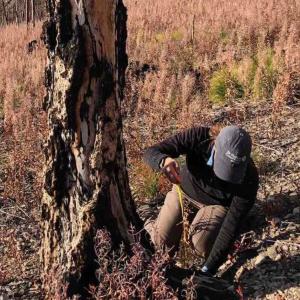Forest Recovery Following Severe Fires
Date
In a new study that examines the severity of fires in combination with hotter and drier conditions plaguing the Western United States, researchers are “seeing the forest for the trees.” Using information from 334 wildfires and 10,000 field plots, collected by more than 50 research teams, this new study, led by NC CASC affiliate Dr. Kim Davis has uncovered a pattern. Forest recovery is limited due to the sensitivity of tree seedlings to hot and dry conditions brought upon by fires burning hotter (which kills more trees) and the drying impacts from continued climate change. That’s the bad news. The good news is that altering how fires burn could significantly increase the chances of forests recovering. “We found that if wildfires burn less intensely, forests will have a better shot at regrowing,” says Davis, who completed the study at the University of Montana and is now a research ecologist with the US Forest Service.
Over the past four decades, warmer and drier conditions have been limiting forest regeneration, with this trend expected to continue in the future. Given the spatial and temporal scope of this study, scientists now have a better idea of the risk to various forests. Forests located in drier regions like the Southwest and California are the most vulnerable to fire, whereas the wetter and cooler forests of the Northern Rockies and Pacific Northwest will still be able to support forest regeneration, at least in the near-future. But the clock is ticking for those forests as well. Over the last century, wildfire suppression and restrictions on Indigenous fire stewardship have contributed to the spawning of mega-fires in the West. Simply put, denser forests with more flammable underbrush can lead to more severe wildfires where more trees are killed, especially in regions stricken with drought.
Forest treatments, like thinning and controlled burns, will help to reduce the fire severity in areas vulnerable to burning. “Our work suggests there is an opportunity to help offset some climate-driven declines in tree recovery by reducing the number of trees killed in wildfires,” says Davis. Studies have shown that benefits of these treatments can include significant reductions in drought-related tree death while increasing tree growth and carbon storage. Re-planting trees in areas that have burned can also help to jump-start recovery, especially where there are few surviving trees to provide seeds. With $3 billion of federal funding allocated over the next decade to ecological forest management and restoration efforts across 50 million acres of Western US forest, this study is a timely one. It reveals the urgency with which action must be taken, given the rapid pace of climate change, but also provides guidance on these next steps.
photo: measuring tree seedlings 5 years following wildfire in western Montana. credit: Daphne Bloom


